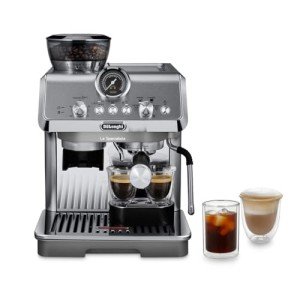Is Your Company Responsible For The Italian Espresso Machines Budget? Twelve Top Ways To Spend Your Money

Heat Exchange Espresso Machines: A Comprehensive Guide
Espresso machines have developed significantly for many years, catering to the needs of home baristas and coffee specialists alike. Among these machines, heat exchange espresso machines have gained appeal due to their ability to provide constant efficiency and remarkable brew quality. In this post, we will check out the operations, advantages, and crucial functions of heat exchange espresso machines, supplying an extensive understanding for both potential purchasers and coffee enthusiasts.
Understanding Heat Exchange Technology
Heat exchange espresso machines run on a special concept that permits synchronised water heating for brewing and steaming. They are equipped with a single boiler that utilizes a heat exchanger system. This feature is substantial as it enables users to brew espresso while steaming milk simultaneously, promoting efficiency in the coffee-making procedure.
How Does a Heat Exchange Espresso Machine Work?
The procedure starts with the machine's water inlet filling the boiler. As the water warms up, it turns to steam. The ingenious heat exchanger uses hot steam to heat additional water in a different passage designed specifically for the brew group. Discounted Espresso Machines indicates that water can reach the ideal brewing temperature level without awaiting the boiler to change. The essential actions include:
- Water Fill: Water is drawn into the boiler.
- Heating Process: The boiler warms up as water is converted into steam.
- Heat Exchange: Steam heats up water in the heat exchanger tube.
- Brewing: Water from the heat exchanger is pressed through coffee grounds, extracting the flavors required for an abundant espresso.
This process permits quick temperature changes and improved coffee extraction.
Benefits of Heat Exchange Espresso Machines
Heat exchange espresso machines provide several advantages, particularly for those seeking to optimize their coffee experience. Here are some essential benefits:
- Simultaneous Brewing and Steaming: Users can brew espresso while steaming milk, making it perfect for hectic coffee shops and home baristas who value performance.
- Temperature Stability: The boiler's steam pressure assists keep a steady temperature, which is critical for consistent espresso extraction.
- Adaptability: The design permits quick switching between brewing and steaming, making it easier to create different coffee drinks, from lattes to cappuccinos.
- User-friendly: Models often feature available controls, making it feasible for both beginners and skilled baristas to produce quality drinks.
- Professional Quality: Heat exchange machines are frequently utilized in commercial settings, supplying users with high-quality brewing efficiency in the house.
Key Features to Look for in Heat Exchange Espresso Machines
When considering the purchase of a heat exchange espresso machine, there are several functions that one must take into consideration:
- Build Quality: Look for machines made from long lasting products, such as stainless steel or brass, guaranteeing durability.
- Boiler Size: A larger boiler will hold more water and sustain higher output over time.
- PID Temperature Control: This function assists keep constant brew temperature levels, which can improve the coffee-making process.
- Group Head Design: Machines with a saturated or semi-saturated group head provide better temperature stability.
- Relieve of Use: User-friendly user interfaces and user-friendly controls enhance the total experience for baristas at all ability levels.
- Steam Wand Quality: A great steam wand with proper insulation and flexibility permits much better texturing of milk.
- Water Reservoir Size: Depending on your requirements, think about how often you wish to refill the water tank.
Contrast of Popular Heat Exchange Espresso Machines
To much better understand the alternatives offered in the market, below is a contrast table of some popular heat exchange espresso machines:
| Machine Model | Boiler Size | PID Control | Price Range | User Ratings |
|---|---|---|---|---|
| Profitec Pro 700 | 2.0 L | Yes | ₤ 2,000-₤ 2,500 | 9.5/ 10 |
| Rocket Espresso R58 | 1.8 L | Yes | ₤ 2,400-₤ 2,800 | 9.4/ 10 |
| Elekta Bianca | 1.8 L | Yes | ₤ 2,500-₤ 3,000 | 9.6/ 10 |
| La Spaziale S1 Vivaldi II | 1.5 L | Yes | ₤ 1,800-₤ 2,200 | 9.2/ 10 |
| Bezzera Magica | 1.2 L | No | ₤ 1,600-₤ 1,800 | 9.0/ 10 |
FAQs About Heat Exchange Espresso Machines
What is the primary distinction in between a heat exchange and a dual boiler espresso machine?
While both types can brew espresso and steam milk at the same time, dual boiler machines have different boilers for brewing and steaming. In contrast, heat exchange machines utilize a single boiler and a heat exchanger to accomplish the same function.
Are heat exchange machines ideal for newbies?
Yes! Many heat exchange machines are developed with easy to use features, making them available for novices. With appropriate assistance and practice, users can quickly produce quality espresso.
What sort of upkeep do heat exchange espresso machines need?
Routine maintenance includes descaling, cleaning up the boiler, checking seals and gaskets, and keeping the group head clean. Routine upkeep guarantees longevity and constant efficiency.
Can I use a heat exchange machine for various kinds of coffee beverages?
Absolutely! Heat exchange machines permit users to produce a range of coffee drinks, consisting of espresso, lattes, coffees, and more.
Heat exchange espresso machines represent a mix of innovation and custom, providing coffee lovers with the tools needed for crafting the best cup. Their ability to concurrently brew and steam, combined with accurate temperature control, makes them an engaging option for both home baristas and professionals. With the ideal knowledge on features and maintenance, users can unlock a world of exquisite coffee experiences, guaranteeing that each sip is as delightful as the last.

